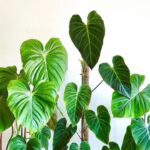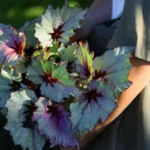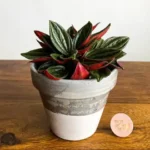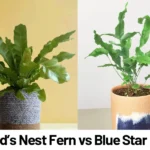Understanding Alocasia Amazonica: A Striking Indoor Foliage Plant
Alocasia amazonica, also known as the African Mask Plant or Elephant Ear, is a stunning tropical plant that brings a bold, exotic touch to indoor spaces. With its deep green, arrow-shaped leaves marked by striking white veins and a glossy finish, this plant is a popular choice among houseplant lovers looking to add architectural drama to their plant collections. Despite its common name, Alocasia amazonica is not native to the Amazon rainforest—it’s actually a cultivated hybrid of two Southeast Asian species. Nevertheless, this eye-catching beauty requires specific care to truly thrive indoors.
Light Requirements
Alocasia amazonica prefers bright, indirect light. Direct sunlight can cause the leaves to scorch, while insufficient light may stunt growth and fade the vibrant contrast in the foliage. Striking a balance is key.
- Ideal Placement: Near an east-facing window or a few feet away from a bright south- or west-facing window.
- Signs of Too Much Light: Brown, crispy edges or bleached spots on the leaves.
- Signs of Too Little Light: Leggy growth and loss of leaf color vibrancy.
If you’re in a space with limited natural light, a full-spectrum grow light can help maintain healthy growth, particularly during winter months.
Watering and Humidity
Watering is often the trickiest part of caring for Alocasia amazonica. This plant likes its soil to be consistently moist but never soggy. Overwatering can quickly lead to root rot, while underwatering may cause leaf drop and dormancy.
- Watering Frequency: Water when the top 1-2 inches of soil feel dry to the touch. This typically means every 5–7 days during active growth seasons.
- Reduce in Winter: Alocasia enters dormancy in cooler months, so water less often while still keeping the roots lightly moist.
Humidity plays a major role in the health of this tropical plant. Low humidity levels can cause the edges of the leaves to brown and curl.
- Keep humidity at 60% or higher for best results.
- Use a humidifier, group plants together, or place your Alocasia on a humidity tray to increase local humidity levels.
Soil and Potting
Alocasia amazonica thrives in well-draining, aerated soil that retains some moisture without staying soggy. A light, chunky mix is best to prevent water from lingering at the roots.
Ideal potting mix formula:
- 2 parts peat moss or coco coir
- 1 part perlite or pumice
- 1 part orchid bark for added aeration
Ensure your pot has good drainage holes, and avoid using dense or clay-based soils. Repotting every one to two years will keep the plant from becoming rootbound and encourage fresh growth.
Fertilizing for Growth
During the growing season (spring through early fall), Alocasia amazonica benefits from regular, balanced fertilization.
- Use a balanced liquid fertilizer (like 20-20-20) every 2–4 weeks.
- For slow-release options, use pellets at the beginning of the season and supplement lightly if needed.
- Stop fertilizing during winter dormancy to avoid root burn.
Always water the plant before applying fertilizer to help prevent salt buildup and root damage.
Temperature Needs
As a tropical hybrid, Alocasia amazonica prefers warm, stable temperatures and is sensitive to the cold.
- Optimal Range: 65–80°F (18–27°C)
- Avoid: Temperatures below 60°F (16°C), especially for prolonged periods
- Keep away from drafts, air conditioners, and heating vents that can cause temperature fluctuations
Common Problems and Troubleshooting
Alocasia amazonica can be a bit dramatic if its ideal conditions aren’t met. Here are some common issues and how to address them:
Yellowing Leaves
Usually caused by overwatering, poor drainage, or cold drafts. Improve soil aeration and reduce watering frequency.
Crispy Edges or Brown Spots
Often the result of low humidity or excessive sunlight. Increase humidity and move the plant to a brighter but indirect light source.
Pests
Common pests include spider mites, mealybugs, and aphids. Remove by wiping leaves with a damp cloth or spraying with insecticidal soap every few days.
Dormancy
If your Alocasia drops several leaves during the cooler months, it’s likely going dormant. Reduce watering and place it in a warm spot with light, and new growth will return in the spring.
Propagation Techniques
Alocasia amazonica is most easily propagated through division—not cuttings—since it’s a tuberous plant.
How to propagate by division:
- Wait until spring or early summer when repotting.
- Gently remove the plant from its pot and look for natural offshoots or baby bulbs (called corms).
- Separate these with clean hands or a sterile knife, making sure each section has roots and at least one growth node.
- Plant the divisions in fresh soil and keep them warm and humid until they become established.
This is a rewarding way to multiply your collection or share with fellow plant lovers.
Tips for Long-Term Success
- Rotate the plant regularly to promote even growth and prevent leaning toward light.
- Wipe down leaves periodically with a damp cloth to remove dust and allow for better photosynthesis.
- Be patient: Alocasia can grow slowly, especially during indoor conditions, but consistent care leads to beautiful results.
Conclusion
Alocasia amazonica is undeniably a show-stopping houseplant, admired for its dramatic leaves and bold patterns. While it does need a bit more attention than some other indoor plants, the effort is well worth it. By providing the right balance of light, moisture, humidity, and warmth, even beginner gardeners can enjoy the striking presence this plant brings to their home. As with most houseplants, observation is key—tune in to the plant’s signals, adjust care as needed, and it will reward you with lush, sculptural foliage and vibrant vitality.
References
- Brickell, C. (2019). The Royal Horticultural Society Encyclopedia of Plants and Flowers (5th ed.). DK Publishing.
- Leone, L. (2021). Houseplants for Beginners: A Practical Guide to Choosing, Growing, and Helping Your Plants Thrive. Rockridge Press.
- Still, J. (2020). The Complete Houseplant Survival Manual. Workman Publishing.








